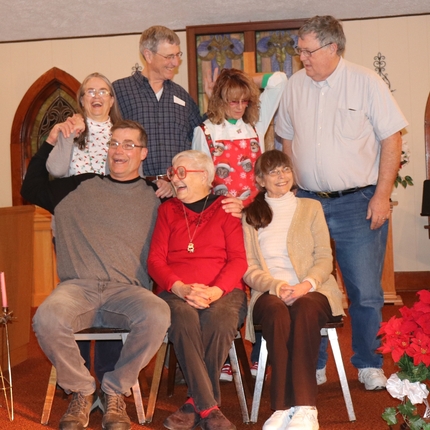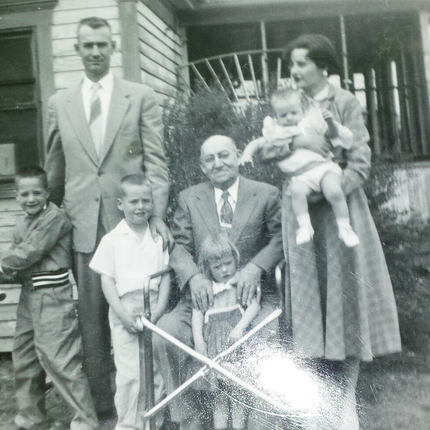Vicky Espinoza contributed to this blog.
At 93 years old, Joan Buhrmann’s top priority is still her family farm.
A witness to many changes on the farm throughout the years, Joan knows there will be even more alterations in the future. One thing she would like to see continue on the farm is the use of conservation practices.
Though they may not have been aware of it at the time, Joan and her husband, Wayne “Red” Buhrmann, started implementing conservation practices on their family farm in 1948.
“To avoid erosion, Red planted grass in the low spots in the row crop fields (swales) to stop the good topsoil from running down into the ditch,” Joan said.
Located 25 miles south of Lincoln, Nebraska, just outside the village of Sprague, the land had been in the family since the late 1800s when the couple took over. Red actively managed the farm, raised cows, hogs, and occasionally chickens. He also planted row crops, then hired out the harvest to friends.
Though Joan was raised in Omaha, and didn’t have much agricultural knowledge, she learned quickly about farm life and enjoyed rural living.
“I chopped musk thistle as well as other weeds,” she said. “At one time, I helped with raising the chickens, and I also chased cows when they got out, all while taking care of the little ones.”
The couple took on farm life together until Red’s death in 1996. Joan then took over management of the farm with the help and advice of her loved ones.
“Whatever needed to be done, I just made up my mind to do it,” she said. “I relied on my children for advice, and I had good neighbors and friends who made sure I had good information to make decisions.”
Joan also made sure to take the time she needed to make those decisions, and stresses that other women in her position should do the same.
“Don't do anything major for a year,” Joan said. “There is so much emotion running through your head at the time when you take over the farm. I was grieving the loss of my husband, and trying to figure out how to keep things afloat. Just take things slow and easy if you can, and don’t be afraid to ask questions.”
Some of Joan’s questions have been answered through sources other than family and friends, including at a Women’s Learning Circle, hosted by the Center for Rural Affairs. Joan and her son, John, took part in an estate planning and soil health workshop in Lincoln last fall.
The Center’s learning circles are peer group sessions that consider participants as the experts on their own production, farmland, and conservation needs. Information, experience, and resources are shared at each circle, allowing women to implement what they’ve learned into their own farm business or operation.
Since Red had always incorporated conservation practices on the farm, Joan, and her son wanted to continue with those practices, and the Center was able to give them practical guidance during the learning circle they attended.
“John and I learned how good soil is formed through the soil health demonstration and discussion,” said Joan. “It was also nice to see there were a lot of women who wanted to know things just like I did. I really appreciated the Center for Rural Affairs sponsoring a class where I could learn more about topics that relate to farming, and are geared toward women.”
Currently, the Buhrmann land is sharecropped, and once the fences are repaired, John anticipates the land will be rented for most of the year and utilized during spring, summer, and fall.
Continued efforts to implement conservation practices are a high priority for the Buhrmanns. John drew up a Forestry Stewardship Management Plan after meeting with a Nebraska Forestry staff member. They hope to improve the farm’s timber and natural habitat to produce more organic material in the soil.
John also wants to use conservation practices to help with clean water and soil preservation and enhancement. He has plans for installing a wetland on part of the property to aid in slowing the erosion of soil into nearby Salt Creek. The wetland would also help clean the water by eliminating Total Suspended Solids, which are the dirty, muddy parts of the water. John feels a wetland would filter this out before it gets to Salt Creek.
A meeting with the Natural Resources Conservation Service aided John in identifying where the wetlands are on the farm, as well as where the highly erodible land is and what can be done about it.
To make the farm profitable, John wants to introduce a fruit orchard as well as continuing with the traditional income streams for small farms.
“I really hope the family will continue the farm,” said Joan. “A small family farm is becoming more and more of a rarity, and this really is a place that is family oriented. Over the years, friends and family would return to the farm and regale us with stories of what they did on the farm, and how many memories were created. It’s such a touchstone for our family—I would hate to see that be wasted or ‘sold out’ to a corporate farm or land development.”
Feature photo: The Buhrmann family celebrates Christmas with Joan in the center.
Second photo: The Buhrmann family poses for a photo in front of the family farm house porch in 1955. Joan (far right) holds her youngest child at the time, Kay. | Photos submitted by the Burhmann family






